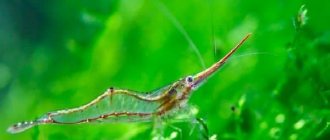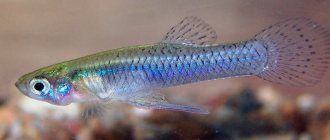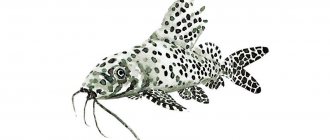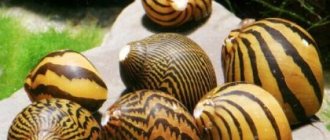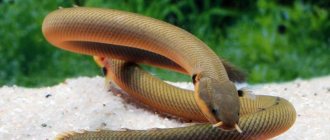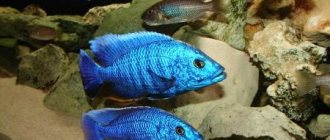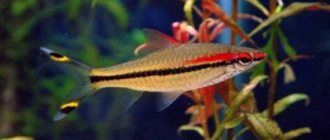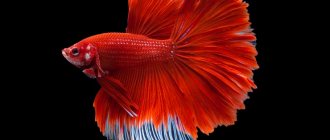Wild Shrimp Crystal
Crystal shrimp (Caridina logemanni) in the wild in its natural color.
However, in Russian-speaking countries the name “Crystal shrimp” has a broader meaning, which refers to all breeding varieties of Caridina logemanni. In Russia and the CIS countries, the phrase “Bee shrimp” is practically not used, and “Tiger” is used only in relation to the popular seafood.
Further, to avoid confusion in the context of this article, Crystal Shrimp will be used as a synonym for Bee shrimp / Tiger shrimp.
Mr. Tail recommends: classification
Crystal shrimp are divided into classes according to the number and location of red and white spots, and the saturation of shades. There are Japanese (C, B, A, S, S+, SS, SSS, SSS+) and German (K0 - K14) classifications. The higher the class, the larger and brighter the white color.
3 higher classes (S, SS and SSS) and 3 lower ones (A, B, C).
| Class | Description | Varieties |
| C = K0 | Species of parent shrimp Unsaturated red color, few white areas. The insides of the wearer may be visible. The distribution of white and red areas is random and variable. White rostrum and caudal fin. | — |
| B = K2 | More white than C, but the body is visible through it. The color is uneven. The rostrum and tail are of a dull red hue. | — |
| A = K4 | Common among amateurs. The predominant color is red, but it is translucent, with 3-4 stripes of white running along the body. The back of the tail and rostrum are also scarlet. | — |
| S = A | Rich red predominates, with fewer translucent zones than in A. | — |
| S+ | A pattern appears of a combination of red and white stripes and spots. The colors are bright and the transition boundaries are without translucent areas. Feature: 4 wide stripes of bright white color. |
|
| SS | The main color is white with splashes of red. The entire back and rostrum are white. |
|
| SSS | Saturated bright white color, only red spots along the cephalothorax. | Masura "Mosura":
|
| SSS + = SSSS | They came from crossing only red shrimp. Their colors are rich, and their legs are also colored. The pattern is the same as on the S-SSS classes, but the colors are more saturated. |
|
Habitat
Despite the fact that these shrimp have become popular all over the world since the mid-1990s, for a long time the general public did not know where exactly they live. Only an approximate region was known - the southern provinces of China. The fact is that due to commercial success, local suppliers tried to keep the habitats secret in order to avoid competition.
However, in 2014, the secret became clear. It turns out that wild forms of Caridina logemanni are found in a limited area near Hong Kong in three streams within just a few square kilometers.
The typical habitat is a shallow stream with a slow flow and a rocky substrate. Depending on the season, the water temperature ranges from 13°C to a maximum of 28°C. The hydrochemical composition has low pH and dKH values.
Breeding
Breeding Red Crystals, especially the higher classes, can result in good profits for breeders.
To reproduce, it is enough to acquire different-sex individuals of the same species. Females are slightly larger than males in size, and their abdomens are thicker. During molting, the female releases sex hormones that attract the male. After mating, after 2 weeks, the female lays eggs, which are attached to the false legs (pleopods) on her abdomen and are incubated for 30 days. Development without metamorphosis, the young are similar to the adult and are independent.
Varieties
Since 1991 (according to some sources, 1993), active selection began due to an accidentally discovered mutation. By 1996, a new color variation had taken hold and received the patented name Crystal Red Shrimp (CRS). On its basis, over decades of active selection, dozens (maybe hundreds) of new color forms have appeared.
Evolution of Shrimp crystal
Schematic representation of the directions of development of breeding varieties of Crystal Shrimp.
The most mentioned forms besides CRS are the following: Crystal Black Shrimp, Golden bee Shrimp, Panda Shrimp and some others.
Description and natural habitat
The progenitor of the Crystal or Bee, the freshwater Tiger shrimp, which inhabits the waters of Japan and China, is inconspicuous: its translucent body is covered with dark stripes. There are several color variations, it depends on the area. Undemanding to the environment, recommended for beginners.
Hiyasu Suzuki, a Japanese breeder discovered that some of the common natural bee shrimp are reddish in color. He took them and crossed them with each other. Through generations, a wonderful form emerged - the Red Crystal. Genetic experiments are still being conducted: they vary the size of the white color or stripes, change the depth of red. The predominance of white in “clothing” is the best option.
The body of the arthropod is divided into a cephalothorax, covered with a shell, and an abdomen. On the head sit black eyes on stalks, capable of seeing 360 degrees. The rostrum is the anterior cephalothoracic section, designed to protect them, and is equipped with teeth. Beneath it are long antennae. There are 5 pairs of legs and gills on the chest. The limbs are multifunctional: with their help, the shrimp captures and brings food to the mouth, moves along the ground, swims, and bears eggs. The lowermost legs of the abdomen were reduced into a caudal fin.
Photo gallery of Red Crystal shrimp:
Maintenance and care, arrangement of the aquarium
By their nature, shrimp are unpretentious, and artificial forms have completely adapted to conditions noticeably different from the natural habitat of wild individuals.
It is recommended to keep crystal shrimp in species or general aquariums of 20 liters or more. In the design, it is important to have potential places for shelter, which can be thickets of small-leaved plants, aquatic mosses, ferns, dried leaves of some trees, or similar artificial decorative elements.
Aquarium maintenance is standard. It is important to maintain a stable hydrochemical composition of water and prevent the accumulation of waste. The water is replaced with fresh water weekly. When choosing a filtration system, you should choose a model that does not cause excessive water movement. Shrimp do not tolerate strong currents well.
Optimal maintenance conditions General hardness - 4-20°dGH Carbonate hardness - 0-6°dKH pH value - 6.0-7.5 Temperature - 16-29°C (comfortable 18-25°C)
Feeding
Shrimp, like all crustaceans, are detritivores, feeding on the decaying remains of plants and animals; some of them should be at the bottom of the aquarium. It is good if aquasoil is used as soil - it is an indispensable nutritional supplement or it is introduced in small portions as a top dressing.
They feed small crustaceans that can be frozen: daphnia, cyclops, moina, brine shrimp, plant-based dry fish food is suitable. They feed with finely chopped fresh or boiled fruits and vegetables, which over time become more attractive to shrimp; microscopic algae grow on them.
It is recommended to add leaves of different plants to the aquarium. They love to scrape rotten wood from aquarium snags.
There are different types of food for shrimp. You can't eat too much protein. But food is added to the aquarium in such quantity that it is eaten in a short period of time, 1.5 hours maximum. Otherwise, the food will begin to decompose, the water will become cloudy, and shrimp and fish will not be able to avoid poisoning.
Conclusion from all of the above
The lifespan of a Red Crystal in an aquarium with good care is one and a half years. By following simple rules, you can completely return all your cash investments to your pocket within six months. What to do with the grown young animals? Every person has the right to do as he thinks. Of course, you can keep them and enjoy the beauty of living crystals, or you can even sell them, which is the most profitable solution. The price of one such crustacean, for example, S-class, is approximately 120 rubles, and the cost of a large SSS-class individual starts from 300 rubles. In conclusion, I would like to focus the reader on the diversity of the aquarium world. You don’t have to have a half-ton aquarium at home, but it’s easy to become a shrimp breeder!!! Try it yourself, because such extraordinary beauty is worthy of becoming a decoration for your home aquarium! And if you have children in your family, they will not be more happy to watch the life of these unusual animals and care for them with love.
Benefits and harms
The appearance of coils in an aquarium is in most cases a random process, however, many aquarists prefer to keep these uninvited guests and find a number of reasons to do this:
- Coil snails are quite beautiful creatures, their twisted shells are extremely decorative. Shellfish add variety to the aquarium and are fun to watch;
- The reels also serve as orderlies, as they eat dead plant leaves, leftover fish food and algae. This does not damage living plants;
- Often, coils act as indicators of the condition of the aquarium. For example, a rapid increase in numbers indicates excessive accumulation of organic matter (overfeeding of fish);
- Finally, reels are valuable food for some species of fish that feed on snails, such as tetraodon.
Coil snails have beautiful shells
But there are certain disadvantages to the content of the coils:
- The simple process of reproduction leads to a sharp increase in numbers, which negatively affects the balance in the aquarium;
- A large number of snails spoils the aesthetics of the aquarium;
- Dead snails can degrade water quality.
Caridina cantonensis
This is the name given to all subtypes of decapod crustaceans kept in aquariums, and are called crystals or bees. The main feature of representatives of this species is the contrasting stripes that decorate the shrimp’s body. These inhabitants of aquariums live from 2 to 6 years, females can grow up to 3 centimeters, males are slightly smaller in size. The color (and they can be white, with black and red stripes) depends not only on the conditions of detention, but even on the mood and environment of the crustaceans. That is why professionals who are experienced in this matter become shrimp aquarists.
And another problem
Another content challenge is compatibility. It is impossible to keep different species together without them interbreeding with each other. The simplest solution to the problem, of course, is to keep the red ones in one aquarium, the black ones in another, and the tigers in a third. But how many amateurs can afford this?
Since all crystals belong to the same species, Caridina cf. cantonensis, they are able to interbreed with each other.
This in itself is not bad, and even makes them genetically stronger, but the result of such crossing is unlikely to please you.
Careful selection work is carried out over the years to ensure that you can enjoy the beauty of the shrimp, and new blood will inevitably affect their color.
For example, tiger shrimp should not be kept with crystals, as the result will be a shrimp that does not resemble either one or the other.
They do get along with and do not interbreed with members of the genus Neocaridina (for example, the cherry shrimp), and the genus Paracaridina, but these shrimp are much less common. Accordingly, they are compatible with other species, such as Amano shrimp or bamboo filter feeder.
Compatibility
Coils are completely harmless mollusks; they can be kept with any calm species of fish, for example, zebrafish, neons, tetras, and guppies. Ancistrus catfish get along well with adult snails, but they can destroy the eggs of catfish.
It is necessary to treat the cohabitation of coils and aggressive labyrinths (cockerels, macropods) with caution. These species pose a danger to young soft-shelled snails
On the other hand, this allows you to naturally regulate the number of coils.
Coils get along well with other invertebrates
Snails are completely incompatible with fish such as loaches or tetraodons. The diet of the latter must include mollusks without fail, so they are often grown as food organisms for these fish. Coils have a “soft” shell compared to other types of snails and are easily eaten by fish.
Related Requirements
The soil in the shrimp tank should be shallow. Sand or small pebbles without sharp edges are suitable; aqua oils, which acidify and soften the water, are optimal.
When choosing plants, it is necessary to take into account that they should be low-growing and unedged. Trimming algae releases substances that can cause the crystals to die. It is good to plant mosses and ferns, pistia and carpet algae, hornwort and liverwort in the shrimp tank. You can also place floating forms. Anubias and cryptocrines are strictly contraindicated for the life of shrimp.
These mobile crustaceans love shelter, so you can decorate the aquarium with driftwood and large stones.
Crystals do not require special lighting, but they look beautiful with it.
Conditions of detention
Shrimps of the lower classes are closest to their wild relatives, therefore they are much more hardy than the selected individuals of the higher class, and can adapt even to conditions that are not the most favorable for them. The lifespan of crystals ranges from 1.5 to 2 years. However, if the conditions of detention are not met, and especially if the temperature increases, this period can be significantly reduced.
Also keep cherry and rili shrimp in aquariums.
Aquarium
Aquarium crystals do not require large spaces. The aquarium requirements for these aquatic inhabitants are as follows:
- A container with a volume of 10 to 20 liters is enough for a flock of crustaceans. When calculating the size of the aquarium, it is necessary to proceed from the minimum requirements, taking into account that at least 1 liter of water is required per individual, so if your flock is small, then a 10 liter glass tank will be enough.
- As for the shape, it is preferable for the shrimp tank to have low walls but a wide bottom. The shape can be either rectangular or square.
- Emptyness in the aquarium is unacceptable. In natural conditions, shrimp prefer to hide in secluded places, crawl along snags, and spend most of their lives in motion. They need a good layer of gravel on the bottom, plenty of decorations to provide cover, and plenty of low-growing and mossy plants.
- But these underwater inhabitants are not at all picky about lighting. They can live both in the shade and in bright light. However, in the light of daylight lamps they look aesthetically much more impressive than in partial shade.
Water parameters
Crystals are extremely sensitive to the chemical and physical characteristics of water, as well as its temperature. If you put these crustaceans in ordinary chlorinated and hard tap water, they will soon die. Representatives of the upper classes are extremely difficult to tolerate any, even minor, changes in the environment, so water changes must be carried out very carefully, while maintaining a stable temperature and chemical composition.
Important! The warmer the water,
the worse the pets feel and the shorter their life, and the color becomes more faded.
As for water requirements, for crystals they should be as follows:
- maximum temperature - +18…+27 °C;
- optimal temperature - + 21…+23 °C;
- acid-base balance (pH) 6.2–7 (the most optimal is pH 6.5–6.7);
- carbonate hardness (kH) - 1–2;
- total hardness (gH) - 4–6.
Thus, the water should be soft, but slightly acidified, and also moderately cool. Crystals are able to withstand short-term temperature changes within the maximum permissible limits (from +18 to +27 ° C), however, it has been noted that for their health it is preferable to lower the temperature rather than increase it.
All environmental parameters in the aquarium should be as stable as possible; this is the key to the well-being of crustaceans:
- To maintain a soft and slightly acidic environment, water is used by osmosis. However, such water is almost completely devoid of minerals. This is bad, since shrimp need calcium to form their chitinous shell, and there is critically little of it in the water.
- In order to compensate for the lack of minerals, you can use part of the settled water, and part - after osmosis. Or simply dilute special mineral supplements in the liquid. As an option, they produce special soils that can influence the acid-base balance. However, methods for regulating chemical properties must be selected individually, since in each region or city water has its own characteristics of acidity and hardness.
- In addition, an important condition for the health of shrimp is the cleanliness of the aquarium. Once a week it is necessary to carry out a partial water change (usually a third), but its chemical properties should not change. Stagnation of water and its waterlogging negatively affect the well-being of shrimp, causing them to get sick, so filtration is necessary. The filter must work constantly.
- Aeration is also indispensable for crystals, because they are very sensitive to oxygen in water. This need becomes especially critical when the water temperature rises above +25 °C, because warm water contains less oxygen than cool water. The aerator must operate around the clock.
House for “jewels”
The aquarium for Red Crystals - a shrimp tank - can be small (10-20 liters) if 4-6 individuals live in it. There is evidence that the minimum volume for 1 shrimp should be about 1 liter. However, a lot depends on the vegetation and scenery. It is preferable to choose a shrimp tank that is not tall, but with a large bottom surface area. If you want the crystals to multiply, then the aquarium must have a volume of at least 50 liters.
Another important fact is that many diseases and death of crustaceans can be caused by overpopulation. Therefore, the optimal biobalance in the aquarium is achieved exclusively by trial and error and by planting young animals.
Reproduction
Breeding shrimp is not difficult for an experienced aquarist. And if you then sell the young animals, your investment in pets will pay off fairly quickly. For reproduction, it is enough to have different sexes. Shrimp reach sexual maturity at the age of 4-6 months, when they reach 2 cm in length.
It is not difficult to distinguish a female from a male. Female individuals are larger, with a full abdomen and a curved underbelly.
When molting begins, the female releases pheromones into the water, by which the male begins to search for her. After fertilization, the female carries the eggs under her abdomen on pseudopods.
The incubation period lasts 20-30 days, then young shrimp hatch from the eggs. Young animals differ from adults only in size. From birth, small red crystals are able to move independently and look for food.
